Subject: Friend, Tame Those Unruly Fingers!
You are getting this e-mail because you subscribed to it on www.learn-to-play-rock-guitar.com. If you don't want to receive these e-mails any longer, go to the bottom of this message and click on "unsubscribe." Hey there Friend, Last week we discussed the need to be sure we're using the most efficient chord fingering as we train our fingers. This allows us to quickly do chord changes that would otherwise sound choppy and disjointed. But along with talk of playing efficiently comes the need to teach the fingers to work independently. Did I say "teach?" Yeah, I meant "force!"Your fingers are a stubborn bunch. They want to do what they want to do. And they will do just that unless you consciously train them to do otherwise. They're bad 'uns! Think about it - when we are talking about individual fingers, we really only use two fingers by themselves - the index finger, for pointing at things, and sadly, our middle finger, for telling others what we think. Try holding up just your ring finger - your middle and pinky fingers want to follow. We're used to making use of all our fingers at the same time to grab on to things, shake or hold hands, write things down, etc. But a guitar neck is not a baseball bat - it requires some finesse to get some decent sound out of it. To become very versatile at guitar, we need to learn how to isolate each finger movement from its neighbors. By doing this, by making our fingers act independently of the other fingers, we'll find it easier to make chord changes, to utilize each finger for greater stretches and to play more interesting riffs. Those wild contortions that some chords call for will become easier and faster to make as well. Speaking of stretches, that is precisely what you should do before picking up your guitar. Stretching the muscles in your fingers, hands and forearms will pay off in flexibility and speed as you learn. I've developed a handout that highlights a few stretches you can incorporate into your practice regimen that will not only increase your flexibility, but also help prevent injuries - yup, believe it or not, you can hurt yourself playing guitar! You can download the Finger Strengthening Exercise guide here. While there are exercises you can do without your guitar (like in the handout), many will find it easier to do finger independence exercises on the guitar fingerboard. The fingerboard gives each finger a place to anchor while working on isolating the movements of a single finger. As an added benefit, with each finger pressing the strings during the exercises, you are building up callouses on the fingertips. One of my favorite finger independence exercises involves placing your four fretting fingers on the first string (high e, the thinnest string). You can start with your index finger on any fret, then place each finger on the next successive fret. So for example, if your index finger is on the fifth fret, place the middle finger at the sixth, the ring at the seventh and your pinky at the eighth fret. Your thumb should be located on the back of the neck under the fingerboard. This position allows your fingers to remain perpendicular to the fingerboard when they are in their resting position on the first string. The idea is to have the fingers well curled so the tips are placed on the first string. Now lift your index finger from its place at the fifth fret on the first string and move it to the fifth fret on the second string. Then move it back to the first string, fifth fret, all the while keeping your remaining fingers in place at their respective frets on the first string. Easy, right?! Yeah, nothing to it. Now repeat the process for each string, again using your index finger. This process most likely won't cause you any grief because we use our index finger all day long. 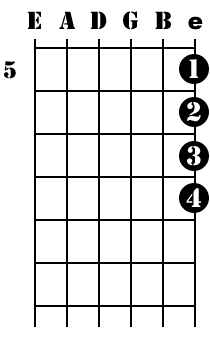 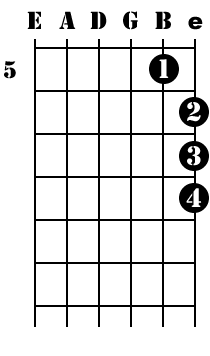 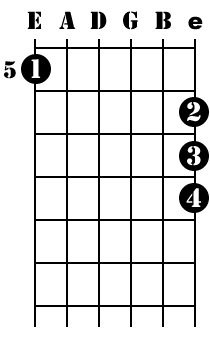 Now that the index finger has been given a short workout, move on to your middle finger. Keeping your index, ring and pinky fingers in place, move your middle finger from the first string to the second string at the sixth fret, then back to the first string. Rinse. Repeat on the third string. And so on. Again, no great challenge, I would suspect (hopefully not because you're using this finger exclusively all day long!). OK, you guessed it, your ring finger is up to bat. I can't imagine there being too much trouble or fight from your finger moving to the second string. Maybe even the third string. No, you're going to feel a fight coming on as you move your ring finger over to the fourth, fifth and sixth strings. Not only will your ring finger be challenged, but you will also feel your pinky trying to move. And here is where you'll start gaining the real benefits of this exercise. By keeping your pinky stationary, you'll be building finger independence not only with your ring finger, but also your pinky! 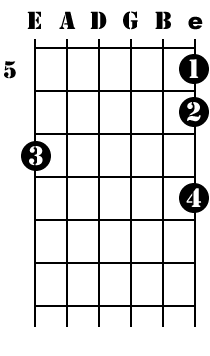 Once the ring finger has its workout, it's time for your pinky finger. Follow the same process moving to each string in succession. The pinky is typically the shortest and weakest of the fingers. You will find that it has a real stretch to reach down to the sixth string. If you need to adjust your thumb placement on the neck, feel free to do so. 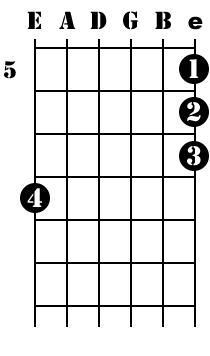 The purpose of this exercise is not to make any notes play clearly. It is merely to get the fingers to move back and forth independently, so don't worry that you aren't pressing the finger into each string. It is enough to simply touch each string with the finger doing the exercise. Also, perfection is not necessary. Movement is. The better you can move your fingers back and forth across the fingerboard, the more benefit you will receive in your playing ability. In this case, it's acceptable to be good enough. Once your fingers get used to this movement, you can increase the speed at which you move them across the strings. You want the movement to be as effortless as possible. This will come in time with a little practice each day. You should begin to see real improvement in your finger movement within a week or two using this technique. I'll work at putting together an ebook with pics to show the full set of exercises, so stay tuned... ~ Time for a shameless plug ~ Speaking of ebooks, I've written a new one. It's called Easy Power Chords - Accelerate Your Playing in Minutes, Not Weeks! This is a bare-bones approach, how-to book with over 240 chord charts showing power chords for every pitch. You also get an unlimited money-back guarantee - unhappy with the font I used or don't like a particular chord chart? Just ask for your money back - and you get to keep the ebooks regardless. Might be dumb on my part, but I'd rather you be happy and we stay friends. I wanted to get this out to you before I formally release it, so if you order from this email link, you'll get the ebook for only $6 (normally $12). I'll be updating this book as time goes on, so anyone that purchases will automatically get all updates as they come out. Updates will include more detailed information about power chords, songs where power chords are used, progressions, more images and maybe even video! Get yourself a little somethin' somethin' for the holidays - Easy Power Chords. Thanks for checking it out, and Happy Holidays! Peace~ Dave Dave "Eddie" Vance is a rock guitar enthusiast and gear nut. He has been playing guitar for over 30 years and enjoys tormenting the neighbors every chance he gets. When he's not slaving for the man, you can find him rocking out with his B.C. Rich Bich guitar, a cold beer and some sweet tunes. He also runs Learn-To-Play-Rock-Guitar.com, but you knew that already! Follow Learn To Play Rock Guitar:I welcome your feedback! Did you like today's message? What other topics would you like to see covered in my e-mails? Please let me know at: dave@learn-to-play-rock-guitar.com As always, please feel free to forward this email to a friend! I review products before recommending them. If you buy a product based on my recommendation, I will receive a commission. However, my emails also contain links that don’t require any investment on your part and are jam-packed with "juicy, guitar learnin' tastiness". We don't rent or share your name with anybody. Feel free to forward this issue to any friends you think would enjoy its contents. They will thank you. So will I.
|


